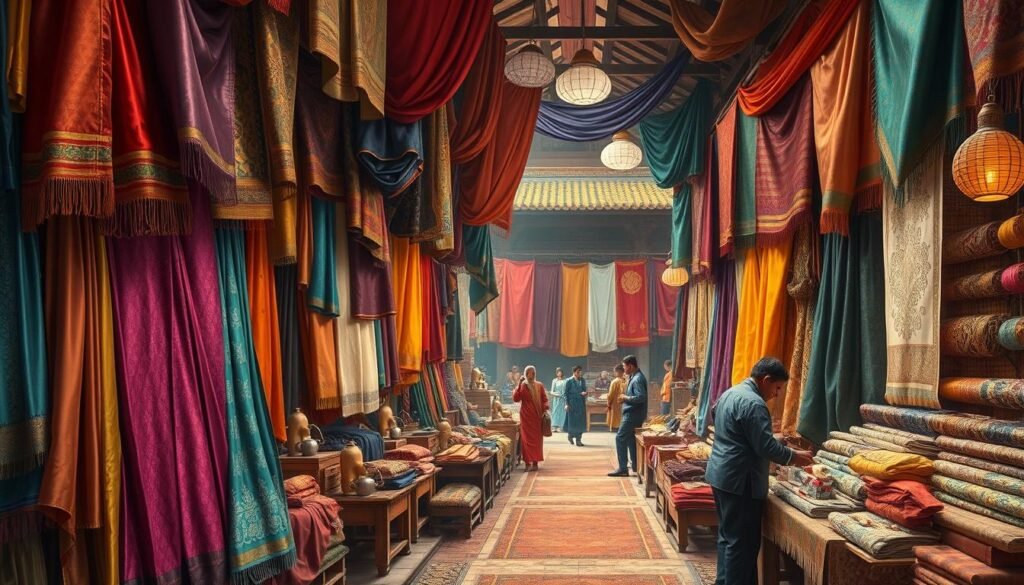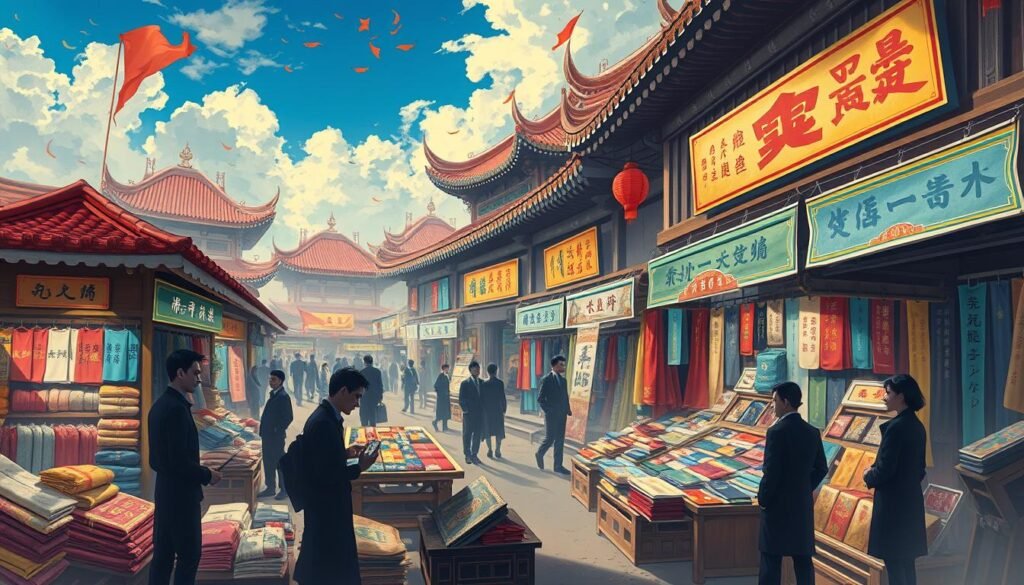“In the middle of every difficulty lies opportunity.” – Albert Einstein.
The silk industry has a long, rich history. Today, it’s at an exciting point. With a value of about $17.2 billion in 2022, it’s growing fast. Experts think it will hit $28.5 billion by 2030. This silk market analysis shows people love high-quality silk. Brands need to innovate and meet these changing needs.
Big names like Anhui Silk Co. Ltd. and AmSilk GmbH shape the silk market trends. Sustainable, luxe custom goods, like custom silk pajamas, are getting popular. Knowing these trends is key for those wanting to make their mark in this field.
Key Takeaways
- The global silk market is forecasted to grow from $17.2 billion in 2022 to $28.5 billion by 2030.
- Innovations and sustainability are pivotal in shaping modern silk market trends.
- Key industry players are driving competitive advantages through quality and customization.
- Consumer demand is increasingly leaning towards unique, high-quality silk products.
- The competitive landscape includes challenges like environmental impacts and competition from synthetic fabrics.
Overview of the Global Silk Market
The global silk market is growing fast, thanks to the textile industry’s love for silk’s luxury. In 2021, the market’s worth was estimated at USD 16.94 billion. It grew at a rate of 7.8% from 2016 to 2021. This growth is thanks to the ongoing demand for luxury clothes and home items.
China and India are the top silk producers. They have been making silk for a long time. This helps them lead the global market. China is the biggest producer and exporter of silk.
Mulberry silk is the most popular type, especially for clothes. The Asia-Pacific region is growing the fastest in the silk market. Countries like China, India, Uzbekistan, and Thailand help this growth.
The table below shows important market stats:
| Year | Market Size (USD Billion) | CAGR (%) | Leading Countries |
|---|---|---|---|
| 2021 | 16.94 | 7.8 | China, India |
| 2023 | 18.7 | 8.30 | China, India |
| 2032 | 34.1 | Projected | China, India |
Silk is also used in beauty products and medicine. This shows how versatile silk is. Companies like Anhui Silk Co. Ltd. and Kraig Biocraft Laboratories, Inc. are big names in this area. Yet, high costs and reliance on Chinese silk are big challenges.
Market Size and Growth Projections
The silk market is growing fast. It’s where luxury meets sustainability. In 2023, its value reached USD 18.7 billion. This rise is due to its popularity in luxury clothes and quality fashion. The silk market has recently performed very well.
Current Market Value
The silk market is very promising. It’s pushed forward by both classic fashion and new uses of silk. Silk is loved for its luxury and being good for the skin. It’s now used in more ways than ever, making it more popular. The growth will be helped by people having more money and choosing natural stuff.
Forecasted Growth Rate
The silk market is expected to grow strongly. It might see a 6.9% increase each year from 2024 to 2032. By 2032, it could be worth USD 34.1 billion. Asia, mainly China and India, will probably lead this growth. They love silk and have the money to spend. But North America and Europe are getting interested too, showing it’s becoming a worldwide trend.
Key Market Players
The silk industry is vibrant with old and new firms boosting its growth. Big companies rule the market with their broad supply chains and creative products. They mix old and new silk ways. This part talks about the leading companies and new ones trying to stand out.
Major Companies in the Silk Industry
Some top silk companies show the industry’s strong make-up. They include:
- Anhui Silk
- Eastern Silk Industries
- ERIS GLOBAL
- Wujiang First Textile Co.
- Kraig Biocraft Laboratories
These market leaders hold a big share by focusing on new and green actions. This matches what eco-aware buyers want.
Emerging Market Entrants
New silk companies are popping up, mainly local crafters and small shops. These emerging silk producers stick to green and organic ways. They aim to draw in buyers who care about where things come from. This offers exciting chances alongside the big names.

Production Processes in Silk Manufacturing
The creation of silk starts with sericulture. This involves raising silkworms. Key to this phase is silk cocoon farming. It also highlights the importance of old methods. These are very important in China and India. Understanding silkworms’ lifecycle shows how it fits into sericulture processes. This ensures high-quality silk. The history behind these methods adds cultural value to the silk industry.
Cocoon Production and Sericulture
Creating cocoons involves caring for silkworms. This leads to the silky threads we use in textiles. Farmers use family knowledge to raise these worms. This raises the product’s quality. The right temperature and humidity are essential for good silk cocoons. New breeding methods are being developed. They aim for better yields and healthier worms, improving silk’s quality.
Innovations in Silk Processing Techniques
New technology is changing silk making. It allows for automated steps, like cocoon reeling with silk production innovations. These updates boost efficiency and silk’s consistency. Producers are now focusing on advanced silk processing. They are using better breeding techniques and fighting diseases. This reduces costs and risks in worm farming. This progress makes silk more attractive to more people.
Companies like Tianruiyi push for top-notch silk. They value quality, sustainability, and innovation. These efforts look good for silk’s future.
Types of Silk and Their Applications
Knowing about different silk types is key. It helps us see how they’re used in many places. Mulberry silk is especially important because it’s high quality and used all over the world.
Mulberry Silk Dominance
Mulberry silk is very important in the silk world. Most of the money comes from it. Bombyx mori silkworms make it, and people love it for its smoothness and fancy look. It’s perfect for expensive clothes and pretty home stuff. In 2022, mulberry silk importance was clear. It made USD 10.7 billion, a big part of the market.
Expanding Uses in Textiles and Beyond
Silk is used for more than just clothes now. It’s finding its way into car fabrics, house decorations, and fashion items. This shows how silk diversification meets new customer needs. It also shows silk’s big role in the industry. In 2022, just the textile part had about 65% of the market.
Silk Applications in Cosmetics and Medical Fields
Silk is now used in beauty and medicine. Its proteins help make skin products and medical stitches. These medical applications of silk use its friendly nature with our bodies. They’re great for making skin look young and healing cuts. There’s a lot of room for these silk items to become more popular, especially in cosmetics.
More progress in making silk and more knowledge about its proteins will likely lead to growth. For more details on silk market size and future thoughts, check out this resource. Also, finding a good silk maker is key. For tips on that, go to this link.
Geographical Distribution of Silk Production
The silk industry has interesting differences across regions. This affects both the making and need for silk. Knowing these differences points out the top silk producers and their global roles. China and India lead, with strong silk-making traditions and the ability to export a lot.
Leading Producers and Exporters
China is the top silk maker, with about 130,000 tons. India is next, adding a lot to the world’s silk. Thailand and Uzbekistan are also key in silk exports. They bring unique silk to the worldwide market. Here’s a table of the top silk countries:
| Country | Annual Silk Production (Tons) | Global Market Share (%) |
|---|---|---|
| China | 130,000 | 65 |
| India | 30,000 | 15 |
| Thailand | 10,000 | 5 |
| Uzbekistan | 9,000 | 3 |
| Others | 24,000 | 12 |
Regional Variations in Silk Demand
Demand for silk changes a lot from place to place. This depends on culture and money matters. Asia is the biggest silk market, thanks to its tradition. Meanwhile, North America wants more luxury silk items because of new fashion styles. Here are the silk demands by region:
- Asia: Mostly likes traditional textiles and clothes.
- North America: Wants more fancy silk for fashion.
- Europe: Has a deep love for silk, especially in fancy fashion.
The value of the silk market could hit USD 37.3 billion by 2032. It’s key to understand these market differences. For deeper knowledge on silk, check out this link.
Market Dynamics and Trends
The silk market is changing a lot because of new tech and what people like. Better ways to make silk help us farm it in a nicer way to the planet. People want things that are made the right way, and that’s changing the market.
Technological Advancements in Sericulture
New tech is making silk easier to make. Things like machines that do the work fast and new ways to breed the silkworms are big news. They help make more silk without hurting the planet as much. We’re also getting smarter about using what we have, which is good for the earth.
Consumer Trends towards Sustainable Products
People now want things that don’t harm the planet. They’re choosing products that are kinder and made responsibly. This push makes brands think about how to make silk without being mean to animals. As this idea grows, it’s changing how silk is made.
| Market Drivers | Market Challenges |
|---|---|
| Technological advancements in sericulture | High costs of sustainable materials |
| Increase in consumer demand for sustainable products | Competition from synthetic fabrics |
| Innovations in silk production | Environmental concerns from production processes |
Both new tech and what consumers want are shaping a bright future for silk. We’ll see more green and smart ways to make silk.
Challenges Facing the Silk Market
The silk market faces big hurdles that affect its growth. High costs and environmental worries are key. These make silk less available to many buyers, slowing market growth.
High Material Costs and Environmental Concerns
Silk making is hard work and costs a lot. This makes it tough to keep silk prices low. Cheaper options are winning over customers. Also, harming the environment and using too much land are big worries. Research shows fixing these issues is crucial.
Competition from Synthetic Fabrics
Synthetic fabrics are tough competition for silk. They’re cheaper and easier to find. This challenges silk makers. They need to show why silk is special. It’s luxurious and lets your skin breathe. Silk makers must also think more about the planet.
| Aspect | Silk Production | Synthetic Fabrics |
|---|---|---|
| Material Costs | High | Low |
| Sustainability | Facing environmental challenges | Less emphasis on sustainability |
| Market Appeal | Luxury and durability | Affordability and functionality |
| Innovation Requirement | High emphasis | Varies |
Silk Market Competitive Landscape
The silk market has both big companies and small producers. They use different strategies to change the business and help new players start. This mix creates an interesting competitive landscape.

North America is leading with top-notch technology and lots of research money. It had a silk market worth USD 3 billion in 2023. This is expected to grow to USD 5.04 billion by 2030. The growth rate is 7.7% each year.
Europe is important too, thanks to strict rules and better production methods.
People want more silk for clothes, beauty products, and medical uses. Especially, mulberry silk is very popular for its top quality. Asia-Pacific is growing fast, thanks to its booming economies and new technologies.
Big companies like Huzhou Silkspark and LANXESS are using smart tech to get ahead. They innovate with big data and AI. Deals and partnerships make the competition even fiercer.
Yet, there are hurdles like high costs and changing prices. But silk’s popularity keeps growing in many areas. The Middle East and Africa are also getting more interested in silk, showing it has a bright future.
Conclusion
The silk market is doing well, changing with the times. It’s set to grow a lot, from $17,200 million in 2022 to $28,535.6 million by 2029. This increase is thanks to things like more people with money to spend and liking for fancy textiles. These points paint a good picture for silk, showing more people want high-quality silk items.
New tech has helped make more silk and use it in new ways. This makes the market bigger. Also, being green and eco-friendly is more popular, thanks to people wanting better products and laws that support this. This move makes brands that care about eco-friendly stuff stand out.
Even with tough competition and possible delivery issues, silk’s future looks good. Innovation, green practices, and changes in what people want make silk more than just a fancy fabric. It’s becoming a key material in different areas. So, those involved in silk have lots of chances to do well in the future.
FAQ
What is the current value of the global silk market?
The global silk market is worth USD 18.7 billion in 2023. It is growing due to demand in luxury clothing and quality fashion.
Which countries are the leading producers of silk?
China and India are at the top for silk production. They are known for their long history and comprehensive production methods.
What is the projected growth rate for the silk market?
The silk market could grow by 6.9% yearly from 2024 to 2032. By 2032, its value might hit USD 34.1 billion.
What innovations are currently shaping silk production?
New methods like automated reeling and advanced breeding are making silk better. These technologies also make production more efficient.
What types of silk are most commonly used?
Most silk used worldwide is Mulberry silk. It’s high-quality and made by the Bombyx mori silkworm.
How is silk being utilized outside of textiles?
Silk is now used in car textiles, home decor, and beauty products. This shows its flexibility and wide range of uses.
What challenges does the silk market face?
Silk production is expensive and faces environmental issues. It also competes with cheaper synthetic fabrics.
How are consumer trends influencing the silk industry?
Consumers want products that are sustainable and made responsibly. This is pushing companies to use eco-friendly processes.
What is the competitive landscape of the silk market?
The market includes big companies like Anhui Silk and Kraig Biocraft Laboratories. There are also new artisans focusing on green silk making.




